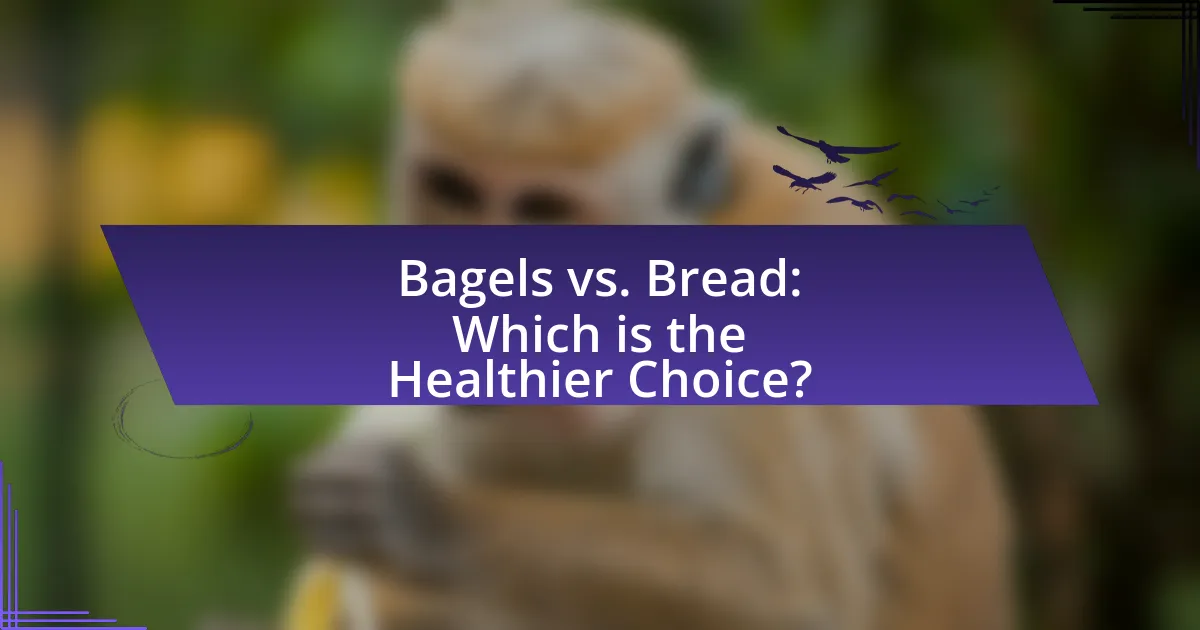Bagels and bread are two popular carbohydrate sources that differ significantly in preparation, texture, and nutritional content. Bagels are boiled before baking, resulting in a dense, chewy texture and a shiny crust, while bread is typically baked directly, leading to a lighter, softer crumb. This article explores the key differences between bagels and bread, including their ingredients, cooking processes, and nutritional profiles, highlighting the implications for health, weight management, and dietary needs. It also examines the role of portion sizes, the impact of refined versus whole grain options, and provides practical tips for making healthier choices when selecting between these two foods.

What are the key differences between bagels and bread?
Bagels and bread differ primarily in their preparation and texture. Bagels are boiled before baking, which creates a dense and chewy texture, while bread is typically baked directly, resulting in a lighter and softer crumb. Additionally, bagels often contain higher levels of carbohydrates and calories due to their denser composition. The boiling process also contributes to a shiny crust on bagels, distinguishing them visually from most types of bread.
How are bagels made compared to bread?
Bagels are made by boiling the dough before baking, while bread is typically baked directly without boiling. The boiling process for bagels creates a dense, chewy texture and a shiny crust, which distinguishes them from bread. In contrast, bread dough is often allowed to rise and is baked in an oven, resulting in a lighter and airier texture. This fundamental difference in preparation methods contributes to the unique characteristics of each product.
What ingredients are commonly used in bagel recipes?
Common ingredients in bagel recipes include flour, water, yeast, salt, and sugar. These ingredients are essential for creating the dough, with flour providing the structure, water activating the yeast, salt enhancing flavor, and sugar aiding in fermentation. Typically, high-gluten or bread flour is used to achieve the desired chewy texture characteristic of bagels.
What is the cooking process for bagels versus bread?
The cooking process for bagels involves boiling the dough before baking, while bread is typically baked directly without boiling. Bagels are first shaped and then submerged in boiling water for about 30 seconds to 2 minutes, which creates a chewy texture and shiny crust. After boiling, bagels are baked in the oven until golden brown. In contrast, bread dough is usually allowed to rise, shaped, and then baked directly in the oven, resulting in a softer crust and a different texture. This distinction in cooking methods is crucial, as it influences the final texture and flavor of the products.
What nutritional differences exist between bagels and bread?
Bagels typically contain more calories and carbohydrates than standard bread. A medium bagel can have around 250-300 calories and 50-60 grams of carbohydrates, while two slices of bread generally contain about 160-200 calories and 30-40 grams of carbohydrates. Additionally, bagels often have a higher sodium content, averaging 400-500 mg per bagel, compared to bread, which usually contains 200-300 mg per two slices. These differences arise from the denser dough and the boiling process used in bagel preparation, which contributes to their unique texture and nutritional profile.
How do calorie counts compare between bagels and different types of bread?
Bagels typically contain more calories than most types of bread. A standard plain bagel has approximately 250-300 calories, while a slice of white bread averages around 70-80 calories, and whole grain bread ranges from 80-100 calories per slice. This significant difference in calorie content is due to the denser composition of bagels, which are made with more flour and often have added ingredients. For instance, a bagel’s calorie count can be nearly equivalent to that of three slices of bread, highlighting the higher caloric density of bagels compared to various bread types.
What are the carbohydrate contents of bagels versus bread?
Bagels typically contain more carbohydrates than bread. A standard bagel has about 48 grams of carbohydrates, while a slice of bread averages around 15 grams. This difference is significant, as bagels are often denser and larger than a single slice of bread, contributing to their higher carbohydrate content.

What health benefits and drawbacks do bagels and bread offer?
Bagels and bread offer various health benefits and drawbacks. Both provide carbohydrates, which are essential for energy, and can be a source of dietary fiber, particularly whole grain varieties. Whole grain bread and bagels can contribute to improved digestion and lower cholesterol levels due to their fiber content. However, bagels are often denser and higher in calories and carbohydrates compared to standard slices of bread, which may lead to weight gain if consumed in excess. Additionally, many commercially available bagels and breads contain added sugars and preservatives, which can negatively impact health. Therefore, while both can be part of a balanced diet, moderation and choice of whole grain options are crucial for maximizing health benefits and minimizing drawbacks.
How do bagels and bread affect weight management?
Bagels and bread can significantly impact weight management due to their carbohydrate content and caloric density. Bagels typically contain more calories and carbohydrates than a standard slice of bread, which can lead to increased caloric intake if consumed in large quantities. For example, a medium bagel can have around 250-300 calories, while a slice of whole-grain bread averages about 70-100 calories. This difference can affect weight management strategies, as higher caloric foods may contribute to weight gain if not balanced with physical activity. Additionally, the glycemic index of bagels is often higher than that of whole-grain bread, potentially leading to quicker spikes in blood sugar levels, which can influence hunger and cravings.
What role do bagels and bread play in a balanced diet?
Bagels and bread serve as significant sources of carbohydrates in a balanced diet, providing essential energy for daily activities. Carbohydrates are the body’s primary fuel source, and both bagels and bread contribute to meeting daily energy needs. Whole grain varieties of bread and bagels offer additional benefits, such as dietary fiber, which aids in digestion and helps maintain stable blood sugar levels. According to the Dietary Guidelines for Americans, whole grains should make up at least half of all grains consumed, emphasizing the importance of including these foods in a balanced diet.
How can portion sizes impact health outcomes with bagels and bread?
Portion sizes significantly impact health outcomes with bagels and bread by influencing caloric intake and nutrient balance. Larger portion sizes of bagels, which can contain around 250-300 calories each, compared to a standard slice of bread at approximately 70-80 calories, can lead to excessive calorie consumption. This increased caloric intake is associated with weight gain and related health issues, such as obesity and type 2 diabetes. Research indicates that consuming larger portions can lead to a 30% increase in overall calorie consumption, which directly correlates with negative health outcomes. Therefore, managing portion sizes is crucial for maintaining a healthy diet and preventing chronic diseases.
What are the potential health risks associated with consuming bagels and bread?
Consuming bagels and bread can lead to several potential health risks, primarily due to their high carbohydrate content and glycemic index. High carbohydrate intake can contribute to weight gain and obesity, as evidenced by studies indicating that diets high in refined carbohydrates are linked to increased body mass index (BMI). Additionally, both bagels and bread, especially those made from white flour, can cause spikes in blood sugar levels, which may increase the risk of developing type 2 diabetes over time. Furthermore, excessive consumption of these products can lead to digestive issues, such as bloating and discomfort, particularly in individuals with gluten sensitivity or celiac disease.
How do gluten and other allergens in bagels and bread affect health?
Gluten and other allergens in bagels and bread can negatively impact health, particularly for individuals with celiac disease or gluten sensitivity. Gluten, a protein found in wheat, barley, and rye, can trigger autoimmune responses in those with celiac disease, leading to intestinal damage and malabsorption of nutrients. According to the Celiac Disease Foundation, approximately 1 in 100 people worldwide are affected by this condition. Additionally, other allergens such as wheat can cause allergic reactions in susceptible individuals, resulting in symptoms ranging from gastrointestinal distress to anaphylaxis. Therefore, for those with gluten intolerance or wheat allergies, consuming bagels and bread can lead to significant health issues.
What are the implications of refined versus whole grain options in both?
Refined grain options, such as white bread and bagels, typically have lower nutritional value compared to whole grain options, which include whole wheat bread and whole grain bagels. Whole grains retain the bran and germ, providing more fiber, vitamins, and minerals, which contribute to better digestive health and reduced risk of chronic diseases. For instance, studies indicate that diets high in whole grains are associated with a lower risk of heart disease and type 2 diabetes, as they help regulate blood sugar levels and improve satiety. In contrast, refined grains often lead to quicker spikes in blood sugar and may contribute to overeating, as they lack the fiber that promotes fullness.

Which choice is better for specific dietary needs?
Bagels are generally better for specific dietary needs compared to bread, particularly for those seeking higher protein content and lower glycemic index options. Bagels, especially whole grain varieties, often contain more protein and fiber, which can aid in satiety and blood sugar control. For instance, a whole grain bagel typically has around 10 grams of protein and 5 grams of fiber, while a slice of whole grain bread usually contains about 3-4 grams of protein and 2 grams of fiber. This nutritional profile makes bagels a more suitable choice for individuals focusing on muscle maintenance or weight management.
What are the best options for low-carb diets between bagels and bread?
For low-carb diets, bread is generally a better option than bagels. Bagels typically contain more carbohydrates, averaging around 48 grams per serving, while standard slices of bread can range from 12 to 20 grams of carbohydrates per slice, depending on the type. Additionally, many low-carb bread options are available that contain significantly fewer carbohydrates, making them more suitable for those following a low-carb diet.
How do bagels and bread fit into a ketogenic diet?
Bagels and bread are generally not compatible with a ketogenic diet due to their high carbohydrate content. A standard bagel contains approximately 50-60 grams of carbohydrates, while a slice of bread typically has around 15-20 grams. The ketogenic diet restricts carbohydrate intake to about 20-50 grams per day to maintain ketosis, a metabolic state where the body burns fat for fuel instead of carbohydrates. Therefore, consuming bagels or bread can easily exceed the daily carbohydrate limit, making them unsuitable for those adhering to a ketogenic lifestyle.
What alternatives exist for gluten-free diets regarding bagels and bread?
Gluten-free diets can utilize alternatives such as almond flour bagels and bread made from rice flour or tapioca flour. These alternatives provide similar textures and flavors to traditional bagels and bread while being free from gluten. For instance, almond flour is high in protein and healthy fats, making it a nutritious option, while rice flour is commonly used in gluten-free baking due to its mild flavor and light texture. Additionally, many brands now offer pre-made gluten-free bagels and breads that cater to these dietary needs, ensuring accessibility for those avoiding gluten.
What practical tips can help in choosing between bagels and bread?
When choosing between bagels and bread, consider the nutritional content, portion size, and intended use. Bagels typically contain more calories and carbohydrates than a slice of bread, with a standard bagel averaging around 250-300 calories compared to 70-100 calories per slice of bread. Additionally, evaluate the fiber content; whole grain bread often provides more fiber, which aids digestion and promotes satiety. Lastly, think about the meal context; bagels are often denser and more filling, making them suitable for breakfast, while bread can be more versatile for sandwiches or toast.
How can one make healthier choices when selecting bagels or bread?
To make healthier choices when selecting bagels or bread, opt for whole grain or whole wheat varieties instead of refined options. Whole grain products contain more fiber, vitamins, and minerals, which contribute to better digestion and overall health. Research indicates that whole grains can reduce the risk of heart disease and improve metabolic health, as noted in a study published in the American Journal of Clinical Nutrition. Additionally, check for lower sodium content and avoid added sugars, as these factors can negatively impact health.
What are some easy recipes that incorporate both bagels and bread healthily?
Easy recipes that incorporate both bagels and bread healthily include bagel sandwiches with whole grain bread, where you can layer lean proteins like turkey or chicken, fresh vegetables, and avocado for added nutrients. Another option is a bagel and bread breakfast casserole, using whole grain bagels and bread, eggs, spinach, and low-fat cheese, baked together for a nutritious meal. Additionally, you can create a bagel and bread salad by toasting pieces of both and mixing them with greens, cherry tomatoes, and a light vinaigrette, providing a balanced dish rich in fiber and vitamins. These recipes utilize whole grain options to enhance health benefits, such as improved digestion and heart health.



